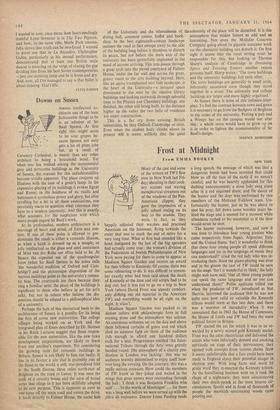Insults and Images
If I followed Mr. Tynan's argument correctly, it seemed that the only art forms that appealed to him were narrative, so his intelligence must be
taking umbrage every time he goes into a concert hall or art gallery. But what made me first think of Mr. Tynan and his raw, bleeding intelligence was the Royal Ballet's recent revival of Ashton's The Two Pigeons and its coupling with Petipa's La Bayadere. Here is a programme calculated to make intellectuals (to say nothing of those who would like to be mistaken for intellectuals) positively squirm.
Ballet is a part-visual, part-muSical art. The arguments it propounds and its appeal to our moral values are not those of the literary drama. Ballet is to the play what poetry is to the novel, and just as poetry can, with its emphasis on imagery, evocation and design, 'insult' the intellectual approach appropriate to an extended prose work, so a ballet can be developed in poetic terms according to its own logic.
If The Two Pigeons were a play it would doubtless be a remarkably silly one. An unlikely Paris painter living in an attic with his mistress/ model, runs off to join the gipsies, and after an affair with a gipsy girl and a beating-up by the gipsy gang, returns to mistress and attic, sadder and wiser. At the level of narrative there are things here to charm the senses, but no one's mind is going to be jolted with the kind of jolt that is the very stuff of the ordinary dramatic theatre.
At this level the story is a cliche. Nor is the Messager music, trickling along like thin lemonade, going to provide any comfort to a musician looking for the mental stimulus of the hard stuff. Yet The Two Pigeons works magnifi- cently as a ballet. It shows us people in love, it touches our heart, it gladdens and inspires us— at least it does me, and one can only speak as one finds. The reason for its success is easy to see. The ballet scores with its dancing, which is basically the only way any ballet really can score.
Ashton's choreography has rarely been at a higher plane. When the two lovers come together in the final pas de deux of reconciliation the dance takes wing. Its effectiveness is difficult to explain, as might be the similar effectiveness of a cinematic image, the astonishing, reverberating rightness of a line of poetry, or the shaft-like sense of beauty suddenly evoked by a painting's composition. Indeed, it is more difficult, because in ballet we have no ready-formulated msthetic standards and critical apparatus to help us in evaluation. I can think of no other art in which the reviewer is so hopelessly reduced to the open- mouthed gasp, and the lame protestation of naked personal preference.
Choreographic beauty cannot be rationalised in terms of technique, as is the custom in music, because at present, having only just acquired an accepted notation, there are still no technical rules of harmony and the like. To this extent it is rather like the art of the cinema, where people Still tend to talk about scripts instead of cameras, attitudes instead of images. In Russia they write about ballet in the same terms, regarding content as more important than form.
I suspect, however, that in ballet form is Content, a concept we accept naturally enough in an art gallery, but fight shy of in the theatre. La BaYadere, or rather the fragment of it now surviving, is virtually devoid of narrative; nothing matters except the generalised personali- ties of the dancers themselves and the actual dances they perform. This is a sort of quintessen- tial theatre, the rarefied Platonic ideal of a dramatic situation.
This is not at all what I meant to write. I Wanted to suggest that La Bayadere and The Two figeons was possibly the best programme the Royal Ballet has ever given us in its entire history. I wanted to note, once more, how heart-rendingly truthful Lynn Seymour is in The Two Pigeons, and how, in the same role, Merle Park success- fully shows that truth can be two-faced. I wanted to point out that in La Bayadere, Christopher Gable, particularly in his second performance, demonstrated that at least one British male dancer is teetering on the verge of closing the gap dividing him from his best Soviet contemporaries —just one stunning jump and he is home and dry. And, now, all I've managed to say is that ballet is about dancing. That's life.
CLIVE BARNES








































 Previous page
Previous page